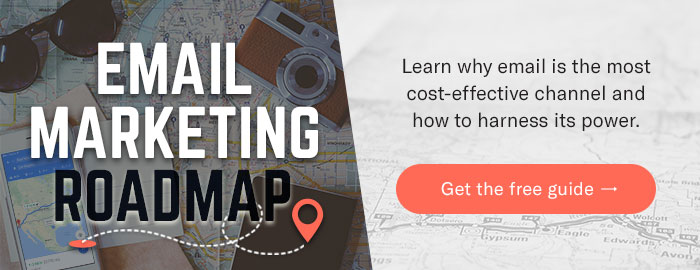Business professionals know staying in front of their customers is a must. One of the best ways to accomplish that is through a smart email marketing strategy. In fact, 86% of professionals prefer to use email when communicating for business and 75% of companies agree email offers a high ROI. Whether it’s a one-on-one conversation or a marketing campaign sent to your entire contact list, follow these email etiquette rules to get the most out of every send.
Bonus Content: Grab a copy of our Email Marketing Roadmap.
1. Streamline formatting styles.
An email full of bold, italicized and underlined text could come across as aggressive, rude, or downright confusing. Keep it simple and keep the formatting to a minimum.
2. SAY NO TO ALL CAPS.
On rare occasion, using caps can work if you need to emphasize something (preferably positive). The rest of the time your audience feels like you’re YELLING AT THEM. Not a great experience.
3. Don’t abuse exclamation points!!!
Using too many exclamation points not only lessens their effectiveness but often makes your words look childish and insincere. Use sparingly, and only one at a time. This applies to emojis, too.
4. Use the name they prefer.
Using a recipient’s name in your email adds a welcome personal touch, but make sure to use the name they prefer. That means if you’re emailing katherine@abcindustries, don’t write “Good morning Kathy,” especially if you’ve never met before. This may be subject to change if or when you establish a more friendly, casual relationship.
5. Ensure your message is clear.
Studies have shown that people misinterpret the tone and meaning of emails as much as 50 percent of the time. Try reading your email out loud or having a colleague give it a once over to see if anything could be interpreted in the wrong way.
6. Don’t try out new material.
Recent surveys have shown that over 50 percent of respondents find humor acceptable in an email. A 50/50 shot isn’t exactly a foolproof plan. What you find funny, someone else may find offensive. Bottom line: if you don’t know the recipient well, or if you’re not sure the joke is obvious, leave it out.
7. Skip the slang.
It’s okay to have a relaxed and friendly email communication style, but you should still sound professional. Despite what you may see on social media, 40 percent of survey respondents ages 18-24 considered slang “totally unacceptable” in emails. Save the BRBs and LOLs for texting.
8. Always provide valuable content.
Seems like an obvious one, but no one wants every conversation to be a sales pitch. If you can provide information or start an interesting conversation, your audience will respond. Learn more about the importance of this concept we know as content marketing.
9. Proofread everything.
A sloppy email with obvious misspellings does nothing for your reputation. Double-check everything. Look your email over top to bottom for grammar, capitalization, punctuation, and spelling. It doesn’t hurt to have another set of eyes look it over to be sure.
10. Make your sign-off count.
Always include your relevant contact information at the bottom of your emails so the recipient knows how to reach you. Create a professional email signature that includes your name, title, company, phone number, and social network links. This gives your recipients multiple ways to get in touch with you.
11. Don’t flood the inbox.
Determining the best email frequency for your business requires some experimentation and trial and error. We send email newsletters twice a month. Find a cadence that allows you to stay top of mind without annoying your recipients.
12. Aim to respond within a day.
If possible, respond to emails within 24 hours. If a proper response is going to take more time, let the sender know you want to give their request the necessary attention and you’ll be following up soon.
13. Know when to Reply All, CC or BCC.
We saved the best (worst?) for last. This is one of the most ignored email etiquette rules that drives people crazy. Here’s the quick usage guide:
- Reply All: use when the conversation is important to everyone in the thread.
- CC: use to include people on a need-to-know basis.
- BCC: use when you’re emailing a large list to keep email addresses private.
Practice these email etiquette rules.
We hope this list of email etiquette rules will help you feel more confident next time you press the send button. We know how complicated email marketing is, but also how important it is to your business. If you’re overwhelmed and need a little help, we’re here to automate the process.



![Better Email Etiquette Equals Better Marketing Results [16 Rules]](https://www.outboundengine.com/wp-content/uploads/shutterstock_411184843-1-400x250.jpg)

